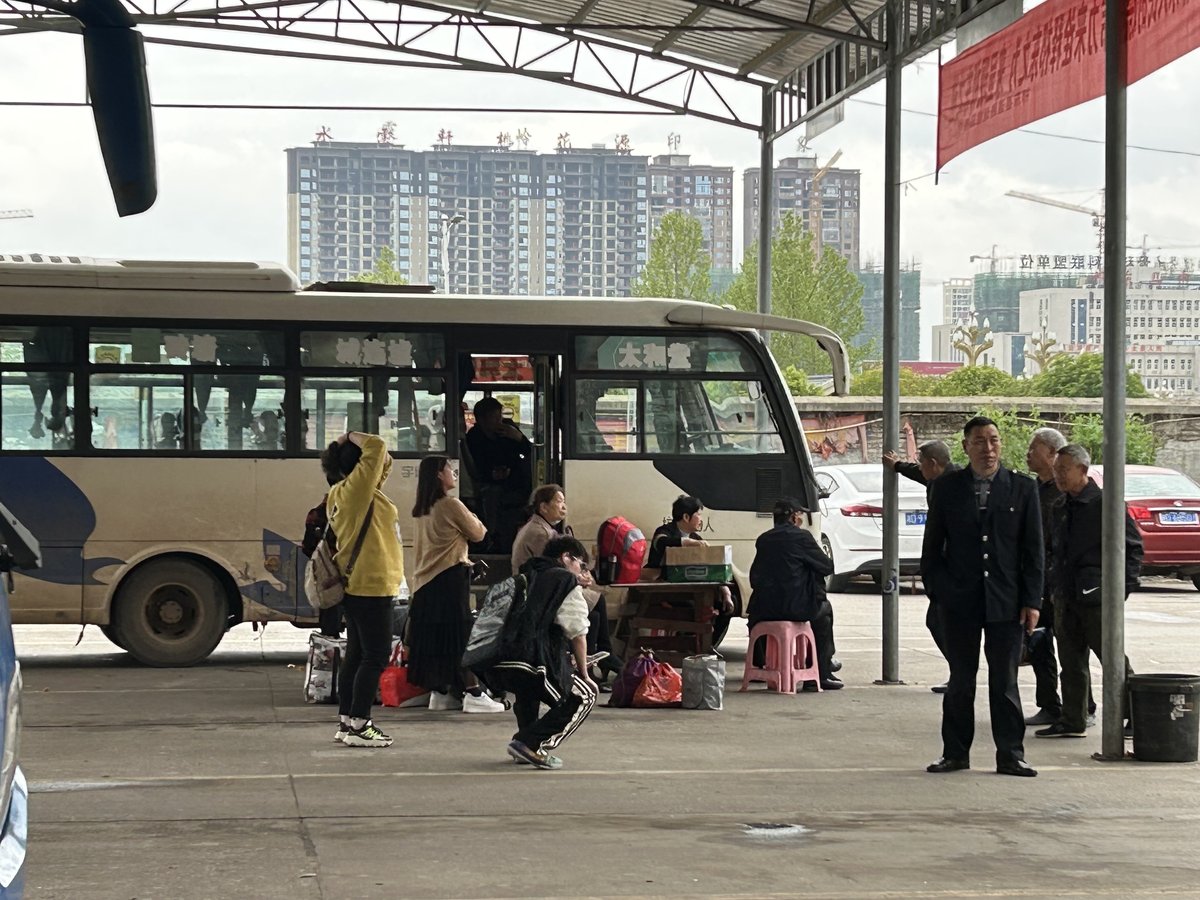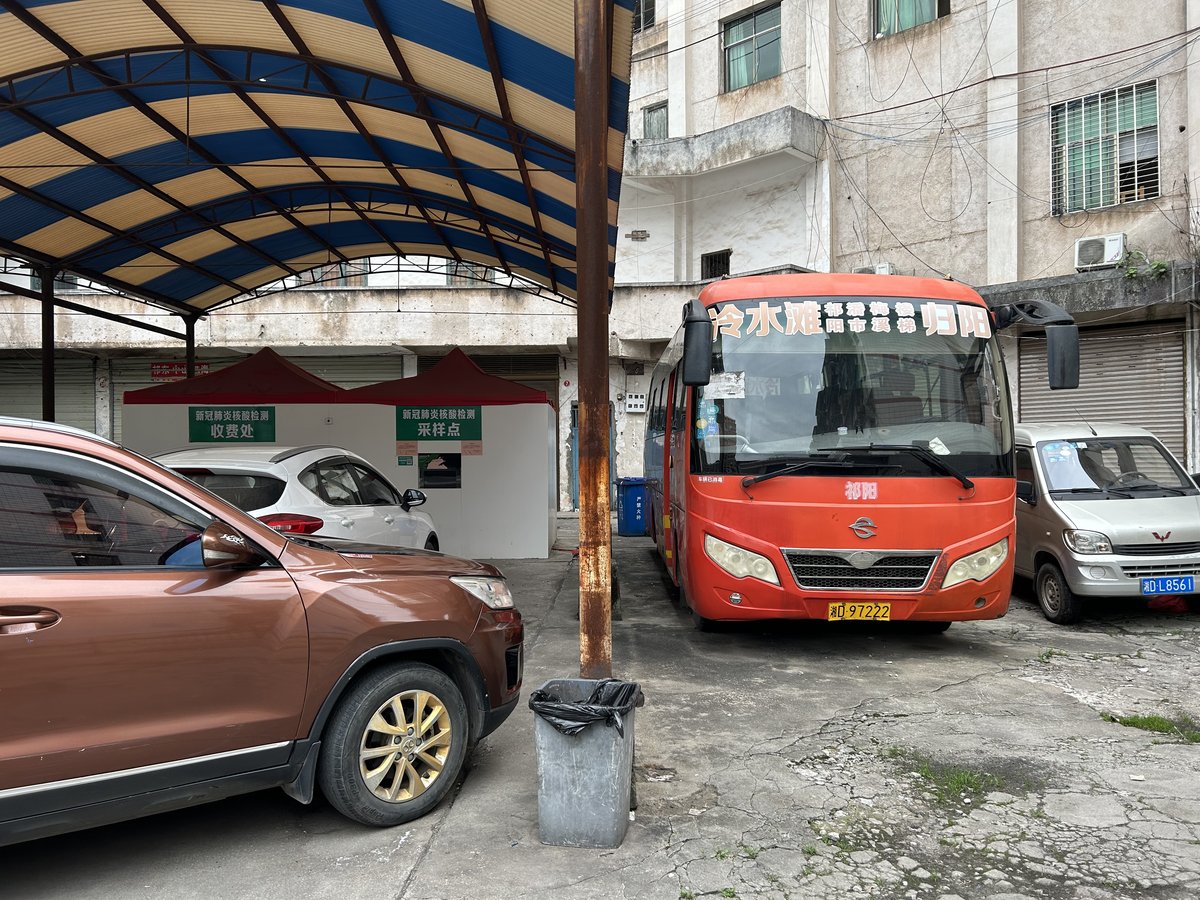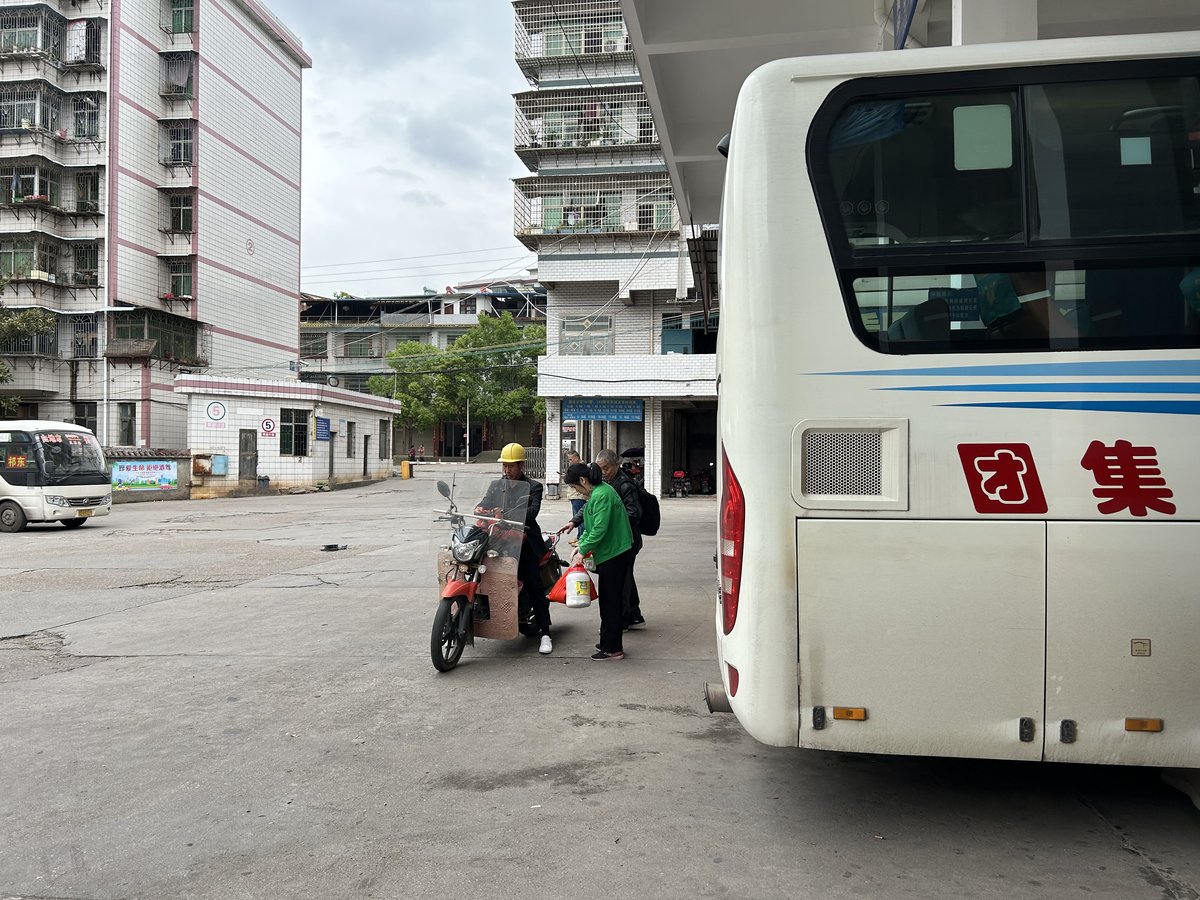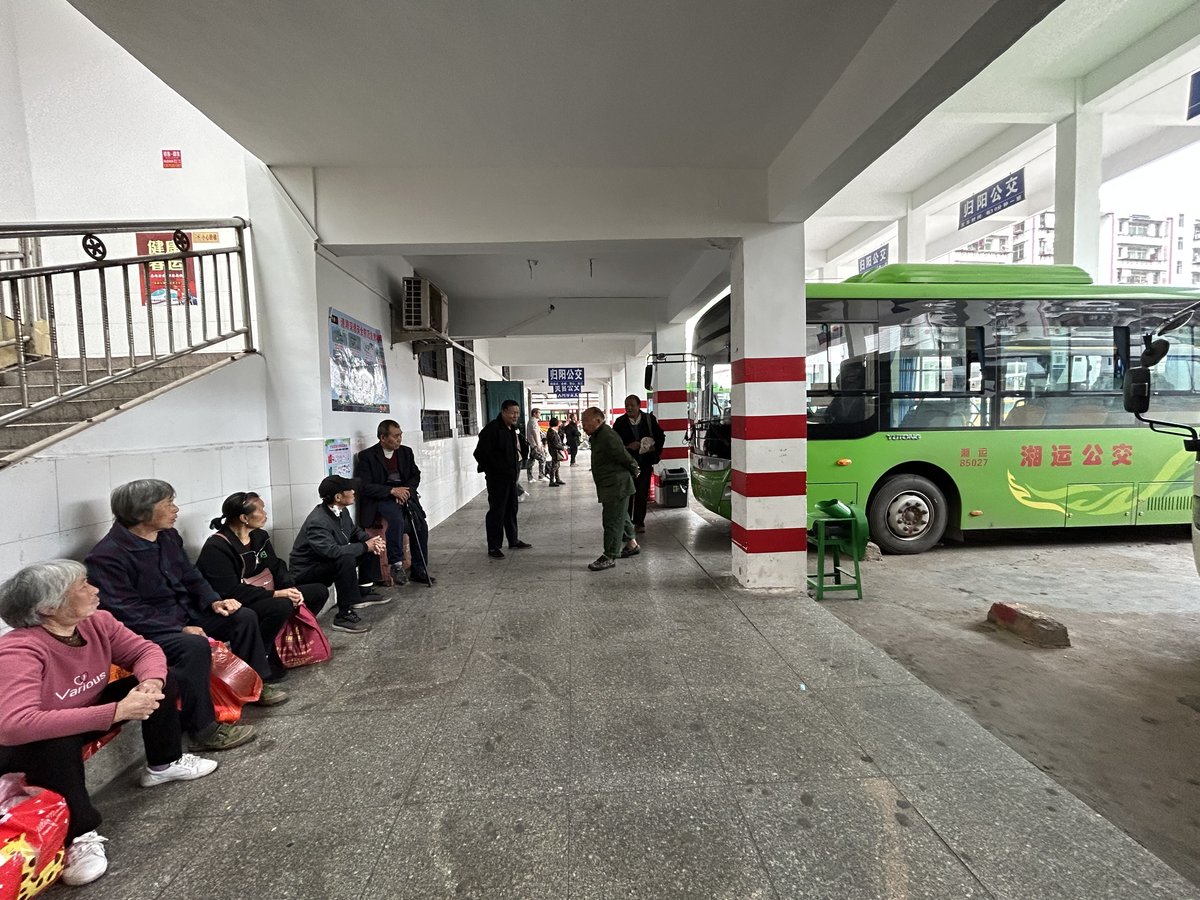With an aging ridership and canceled routes, China’s intercity buses struggle to survive
“Qidong! Qidong! Going to Qidong? All aboard! We’re leaving…” a female attendant hails me from a bus stop as I step off the No. 115 intracity bus at Huaxin Coach Station in Hengyang, Hunan province. It awakens in me a familiar feeling, both sad and happy: I’ll be home soon, though it’s a bumpy ride of over 110 kilometers or three hours ahead to my home village in Buyunqiao town, Qidong county, usually on a standing-room only coach where people jump on and off along the way.
This 29-seat bus, one of several that cumulatively run 30 times a day from Hengyang to the city’s Qidong county, has been my most reliable means of traveling home over the last two decades. From the time I started college in downtown Hengyang, then found work in Shenzhen and Beijing, and until the Covid-19 pandemic in early 2020, I made this trip at least once or twice a year. I often traveled during the National Day and Lunar New Year holidays, along with other students and workers going home.
Huaxin Coach Station opened in 2003, and reportedly can run 800 bus shifts with capacity to carry 11,000 passengers daily. It connects downtown Hengyang with the towns and villages in Hengyang, Qidong, and Hengnan counties in the southwest, whose combined population totaled over 2 million by the end of 2021. During the National Day holiday from October 1 to October 7 in 2016, over 21,000 passengers took buses here, many of them first arriving by train or plane in Hengyang from other cities or provinces. On October 1 that year, deterred by the seemingly endless lines to board the bus, many people heading to neighboring towns, including me and a similarly hopeless family of three, carpooled using ride-hailing apps like DiDi instead.
By comparison, on the morning of Sunday, April 9, 2023, it’s a totally different scene. Instead of crowds of homebound travelers, I count less than two dozen passengers walking up to pay fares during the two hours I spend there. They are mainly students, seniors, or families with kids. When the bus leaves the station at noon for downtown Qidong, around 60 kilometers away, I’m the only passenger on board except the driver and attendant, who say the previous bus left 20 minutes ago with the driver alone.
The days when a “sea of people” queued in and out of the station for a seat or standing space on the bus have gone, the ticket-seller, whose surname is Li, complains. “We now sell only 300 to 400 tickets a day. Tickets start at 5 yuan, and even the most expensive ticket [for the farthest distance] is 32 yuan…It will only get worse and worse.”
Empty coaches, declining demand
In fact, this bus station and the 15-floor office building above it have been on shaky financial ground for years. Its owner, the Hengyang Automobile Transportation Group (HATG), went bankrupt last January, leaving an uncertain future for its more than 3,900 employees, 1,300 buses, and 49 bus terminals in surrounding towns and districts, according to numbers shown on its website (which stopped updating in July 2021).
While demand for bus services has been on a general decline, many locals, especially the rural elderly, still need them to travel into towns and cities to buy food, visit hospitals, and access other services.
Around the country, the bus transport industry, including both intercity and intracity buses, has been struggling: The number of passengers has decreased, bus shifts have been cut, routes have been canceled, and terminals have closed. In 2021, 42 passenger transport terminals were shut down in Guangdong province alone, including the 43-year-old Shajing station in Shenzhen, which suffered plummeting number of passengers and “severe deficit” due to the impact of high-speed trains, car hailing services, and the pandemic, as the station reported.
This March, Hankou North Passenger Transportation Center, the largest passenger transport terminal in Wuhan, closed less than three years after its opening. Haikou East Station in the capital of Hainan, China’s southernmost province, shut down this April after three decades of operation.
From 2012 to 2022, the mileage of railway in China increased from 98,000 to 155,000 kilometers, including 42,000 kilometers of high-speed rail covering the majority of China’s 293 prefecture-level cities. Meanwhile, the volume of highway passenger transport peaked in 2012 at 35.57 billion trips, and fell to 5 billion in 2021 after the outbreak of the Covid-19 pandemic, according to the Ministry of Transport.
Routes canceled, stations bankrupt
The bus industry is doomed, “as people now have more options for transport,” asserts Fang Jie, who has been a ticket-seller at Qidong Coach Station for over 20 years. Fang, who didn’t want to give out her real name, explains that more and more people have their own cars. They are also willing to pay double or even triple price to take high-speed trains, for the comfort and to cut down their travel time by a third or even half compared with coaches.
Established in 1989 by the HATG’s Qidong branch, Qidong Coach Station, serving a county of more than 760,000 people in western Hengyang, has decayed in many ways. Within four years after the launch of Qidong’s new railway station with high-speed train services in 2013, its long-distance coach routes to cities outside of Hunan were canceled. Neighboring Guangdong province was the only exception, and the formerly dozen coaches per day to various parts of Guangdong were cut to only one every two days. The parking lot originally reserved for inter-provincial buses is now occupied by an out-of-use Covid testing kiosk, several private cars, and a retired coach that has languished there for at least two years.
Similarly, the number of buses from Qidong to Hengyang city dropped from around 40 per day (one shift every 20 minutes) to only eight (one per hour). Buses to the neighboring Qiyang county, which also got high-speed trains in 2013, fell from eight to two per day.
It’s a struggle to even find the coach station now, as its ticket hall is sandwiched between a large drug store and a nightclub refurbished from the station’s former waiting lounge. Last year, the HATG began to delay payment of employee salaries, and Fang has not seen a penny for half a year. Li, the ticket-seller at Hengyang’s Huaxin Station, is still getting her salary, but with a one-month delay. The company has not been making regular social insurance payments for its employees for years.
Li partially blames the Group’s fall to its privatization in 2000, which led to managers “exploiting the common workers and the former state assets for their own benefits due to the lack of [state] supervision.” The two disappointed women, both in their 40s, hope that the company can go through bankruptcy procedures as soon as possible so that they will be made redundant with compensation for their over 20 years of service here, and then find new employment.
On the April afternoon I arrive at Qidong Coach Station, Fang and her two colleagues, one in charge of the security check and one ticket-collector, are getting off work at 4:30 p.m., though there is a Hengyang-bound bus scheduled at 5 p.m. “There are no passengers.” Fang takes a final look around the station to be sure there is no one waiting for the bus, before she and her colleagues lock the door and leave.
“We can’t help it,” Fang says, in response to some passengers’ complaints about the long waiting times and the inconvenience of bus service nowadays. Some still prefer taking buses to and from Hengyang to work, school, or the hospital. They find the location of bus stations and stops to be more convenient than the suburban railway stations, and those who own cars may take the bus anyway to avoid having to look for a parking space in the city.
Village taxis...with no passengers
Rural buses, especially those that travel between villages, have also been disappearing.
The buses from Baoshengdian village to downtown Qidong and Buyunqiao town, from which one can connect to a bus bound for Qidong every 15 minutes, all stopped running last year, a resident surnamed Zhou from Baoshengdian tells me. This 52-year-old had a friend hail a taxi for her at the expense of 100 yuan to get to Qidong, where she is transferring to another coach that will take her to another city to live with her son’s family and take care of her grandchildren.
She says some old villagers still regularly go to Buyunqiao town on market days to buy clothes, food, and other necessities, or to sell their own farm produce. Unwilling to pay 40 yuan for round-trip fare on a motorcycle, they choose to walk over 10 kilometers each way.
“Now people are better off [economically], but things have become less convenient,” Zhou speaks on behalf of the rural elderly, recalling that the bus fare from her village to Buyunqiao has increased from 0.4 yuan to 6 yuan in the last three decades. Though many local families own a car or motorcycle, it’s mostly the young family members working in the cities who drive them. Just like Zhou, when their children do not drive their car back to the village during holidays, elders need to find a way to travel around on their own.
“As long as the driver can make a living out of the business, they won’t stop working,” says Wang Xiaorong, owner and operator of a 19-seat bus licensed under another transportation company in Qidong. But this is getting harder. Wang, who drives the bus, and his wife, who sells tickets onboard, have transported residents in their village and other villages (including mine) to Qidong county and several other towns along their 63-kilometer route for more than 20 years, departing at 5:30 or 6 a.m. each day all year round.
But they plan to quit the business next year, despite their seven-year-old bus still having three years to run on its permitted service life (and with little prospect of finding a buyer for it).
When I went to high school in downtown Qidong in the early 2000s, people were sometimes unable to cram onto Wang’s bus on its busy days. On those occasions, passengers, including many students returning to school from the holidays, either had to walk several kilometers to take a bus that only runs on Buyunqiao’s market days—days ending in 1, 4, and 7 in the calendar—or hail a motorcycle on non-market days.
But on a Monday morning this April, when I meet Wang at Qifeng Parking Lot, a departure point for buses serving the western part of the county including Buyunqiao, there are more drivers and conductors than passengers. They are gathered in groups to play cards or chat, waiting for passengers so they can run their scheduled two shifts a day (one in the morning and one in afternoon). By the time Wang’s bus leaves at 9 a.m., there are only four riders. Besides Wang, his wife, and me, the others are mostly seniors returning home from hospitals in town.
The buses here are licensed under the HATG or one of the county’s other two major transportation companies, though they’re mostly owned by the drivers themselves. Under regulations implemented over a decade years ago, bus owners aren’t allowed to operate independently, but must (at least nominally) be under a licensed transportation company. This arrangement often involves nothing more than bus owners (alone or as a group) paying the company a regular “management fee” to register with them.
The fees contribute to the struggle for profitability. “Now there are only a few passengers for a single trip, and sometimes the fares cannot even cover the cost of gasoline,” Wang complains. Tickets range from 3 to 19 yuan depending on the distance, while gasoline costs 100 yuan per trip. Apart from the rise in car and motorcycle ownership, there are just fewer and fewer people living in the countryside in general, especially those of adult working age: between 20 and 60 years old.
Jiang Rongfei, who drives two 50-kilometer round trips each day between his village Huangmatang to Qidong Coach Station, has also made the decision to quit next year. He previously worked in Guangdong province, but started his bus business with his wife in March 2019 after returning home to take care of his elderly parents.
The couple makes around 60,000 yuan a year. This does not leave them much in profit, as they have to pay the transportation company over 10,000 yuan each year for the license, and around 1,000 yuan to Qidong Coach Station for parking. Buying a second-hand bus cost them 60,000 yuan (a bargain compared to the 300,000-yuan cost of a new one, Jiang says). Jiang believes business will get worse as more and more of the elderly, who make up most of his passengers, grow old and die.
Will villages get left behind?
Tan Zaisheng, one of Wang’s regular passengers, says that if the bus stops running, he’ll need to pay double the price to hail a motorcycle to and from town. Each month, the 62-year-old farmer comes to the downtown county to get diabetes and heart disease medicine for his wife at the only hospital covered under their health insurance.
According to Wang, the government is aware of the problems with rural buses, as some villagers have complained about them. Officials have visited the Qifeng Parking Lot several times over the years, but no progress has been made, and Wang believes the local officials “don’t have much power to do anything” or are “simply going through the motions.”
Over the last few years, the government-issued gas subsidies for 19-seat buses like Wang’s have been cut by nearly half, and the payments have been delayed. “I haven’t got the subsidies for 2021 yet,” Wang says.
Jiang predicts that rural buses like his will die out in a few decades, since most younger people can drive. However, the government is more optimistic: As announced on the official website of the Hengyang government, Qidong has been constructing a new passenger terminal at the cost of over 37 million yuan beside its railway station since 2021, to promote the local economy, improve Qidong’s image, and facilitate transportation to its residents.
After construction, it may cut the time of my next trip home by at least half an hour. Jiang, however, remains pessimistic: “The government may guarantee buses to the towns, but not villages.”
Last Bus Home: Are China’s Coach Services Doomed? is a story from our issue, “After the Factory.” To read the entire issue, become a subscriber and receive the full magazine.

















